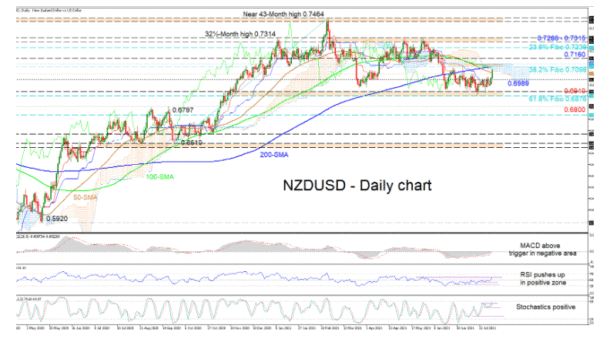NZDUSD recently acquired a surge of positive momentum, resulting from stronger New Zealand job numbers for Q2, which has managed to somewhat neutralise the neutral-to-bearish bias in the pair. The falling 50- and 100-day simple moving averages (SMAs) and their recently completed bearish crossovers of the 200-day SMA are endorsing downward price action, in spite of the latest neutralising developments in the pair.
The Ichimoku lines are indicating a drop in negative forces, while the short-term oscillators are reflecting the upbeat mood in the price. The MACD, in the negative region, is above its red trigger line and is tackling the zero threshold, while the RSI is improving in the bullish zone. The stochastic oscillator is sustaining a positive charge as it approaches the 80 level, promoting additional buying interest in the pair.
To the upside, preliminary friction could emanate from the resistance zone shaped between the 0.7098 level, which happens to be the 38.2% Fibonacci retracement of the up leg from 0.6510 until 0.7464, and the Ichimoku cloud’s upper surface of 0.7120. Pushing above the converged 100- and 200-period SMAs around 0.7100 and the cloud, the price could then hit the 0.7160 nearby high. Additional optimism in the pair may result in the 23.6% Fibo of 0.7239 testing buyers’ efforts to conquer the neighbouring ceiling of 0.7286-0.7315.
Otherwise, if sellers retake control and drive the price below the 50-period SMA at 0.7045, the 0.7000 handle – reinforced by the Ichimoku lines from beneath at 0.6989 – could prove to be a durable support. However, diving below this obstacle, sellers may challenge the support boundary from 0.6910 until the 61.8% Fibo of 0.6876. Should negative pressures gain a clear advantage, they could then sink the pair towards the 0.6800 border.
Summarizing, NZDUSD is ranging between the 61.8% Fibo of 0.6876 and the cloud’s upper band of 0.7120. A break either below or above these respective limits could reveal a clearer price direction in the near-term timeframe.













